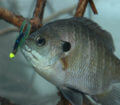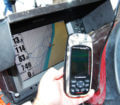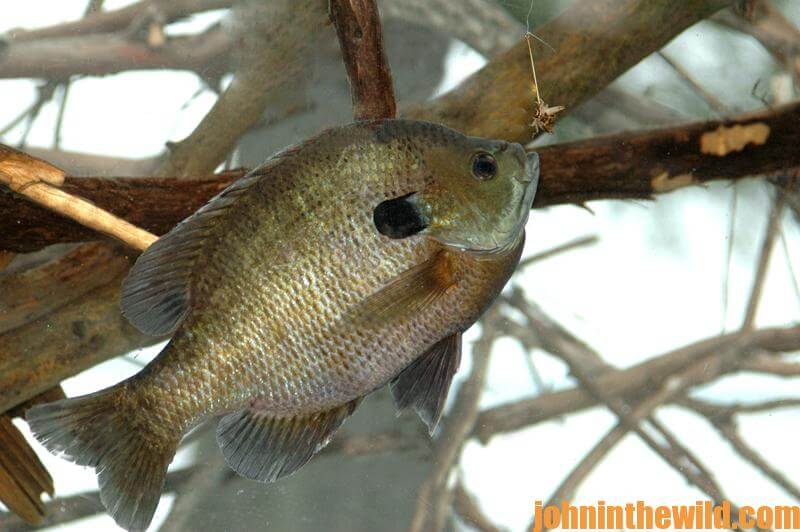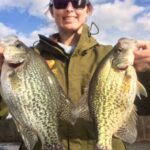Editor’s Note: Most fishermen, especially those in the Deep South, will name May as the month for catching big bream, and particularly the time around the full moon in May. But, to catch bluegills that weigh almost 5 pounds, certain conditions have to come together to produce a new world-record bluegill. Just like you can’t take a trophy whitetail, if a trophy whitetail doesn’t live on the property you hunt, the same is true for catching monster-sized bream. This week let’s look at what ingredients must come together to produce a big bream, which for most of us would be a 1-1/2 to 2-pounder.
During the spring and summer, anyone can catch bream, which will be around piers, under willow trees and in most shallow water. In the more-rocky terrains, they’ll be in little pools and shady spots on the side of the rocks and boulders and under the rocks waiting on the bait to pass by. These will be the average to small bream – the bream that anyone can catch, and that most breamers do catch. But, to take big bream – monster-sized bream – the ones that grew big and smart by avoiding hooks, we must understand them. First of all, these big bream are shy and extremely wary. The subtle mistakes that most bream anglers make are the mistakes that the big bream key in on and avoid. For instance, oftentimes, large, smart bream can see a hook in bait. So, one of the tactics that may work the best on big bream is to bury or camouflage the hook as much as possible in the bait.
 Growing Your Own Bream and Using a Depth Finder:
Growing Your Own Bream and Using a Depth Finder:
If you know someone with a farm pond where you can fish for bream, offer to fertilize his pond and/or set-up a fish feeder on the pond in return for being able to fish the pond. Often pond bream travel around a pond by tending to move in schools and spreading out horizontally over a large portion of the bottom. By using a depth finder, you can know the distance you are from the bream and fish for the deep-water bream before fishing shallow, which keeps you from alerting the shallow-water bream to your presence.
Flyfishing for Bream:
Big baits must be employed for big bream. A No. 8 hook is the normal size for flyfishing with most bream bugs. However, a No. 6 hook will allow you to miss the small bream, while hooking only the big ones. Once you have the right-size hook on your bream bug, the color and the number of legs the bug has are the next considerations. Most commercial bream bugs don’t have enough legs to suit the trophy-bream flyfishermen. Rubber legs create action on the water and draw bream to the bug. A big, old bluegill is just like a 85-year-old, 300-pound man sitting in his rocking chair on his front porch. When a pretty girl walks by, he may notice her and momentarily stop his rocking. But, when a beautiful blond in a tight sweater and a short skirt and her backfield in motion comes slinking down the sidewalk, not only will he notice her, but he may get out of his chair, pick-up his cane and walk-out to meet her. He may only say, “Good morning,” or “Isn’t it a beautiful day,” but she has definitely held his attention. Well, that’s what happens when a bream bug has lots of legs. Those legs go to shimmering and shaking, and a trophy-size bream just has got to come off his porch to take a bite.
The visibility of the bait has a great deal to do with whether or not a bream will bite, because the fish can’t hit what it can’t see. Most flyfishermen consider white the best color for catching buster bluegills. Although yellow is the next-best choice, black will be the most productive in clear water. Of course, some bream flyfishermen swear by chartreuse. “Why, every serious flyfisherman I know uses chartreuse, and we always catch bream,” an old angler once told me. Although there’s no scientific evidence to prove that chartreuse is the best color, like you, I know that when an angler believes in a bait, he’ll catch more bream. So, if you’re a die-hard chartreuse flyfisherman, stick with your color. But, you may be surprised at what you can catch on white and yellow. Spots, stripes and pretty designs on bugs are decorations more to catch customers than fish. But, if you feel your bug has to have polka dots to catch fish, by all means, get a polka-dot bug. It won’t matter to the bream.
 The late Alf Van Hoose of Birmingham, Ala., developed a technique of catching and baiting quicker when he was flyfishing for bream with crickets. “I use a tiny hook and light line, because I believe a smaller hook and smaller line is easier for a bream to get into its mouth and swallow the cricket. And, unless you really know what you’re doing, you’ll spend all afternoon just trying to get that small hook unhooked from that bream’s mouth. When you take a lot of time to get a fish off the hook, you’re lessening your time to fish. So, I try to lip-hook the bream to remove it faster. To lip-hook a bream, you must set the hook as soon as you see the cork move or the line twitch. Sure, I’ll miss a few bream like this. But, if I miss a bream I can swing right back to it and give it another shot at the bait. If I do hook it, I can get it into the boat easily and off the hook quickly.
The late Alf Van Hoose of Birmingham, Ala., developed a technique of catching and baiting quicker when he was flyfishing for bream with crickets. “I use a tiny hook and light line, because I believe a smaller hook and smaller line is easier for a bream to get into its mouth and swallow the cricket. And, unless you really know what you’re doing, you’ll spend all afternoon just trying to get that small hook unhooked from that bream’s mouth. When you take a lot of time to get a fish off the hook, you’re lessening your time to fish. So, I try to lip-hook the bream to remove it faster. To lip-hook a bream, you must set the hook as soon as you see the cork move or the line twitch. Sure, I’ll miss a few bream like this. But, if I miss a bream I can swing right back to it and give it another shot at the bait. If I do hook it, I can get it into the boat easily and off the hook quickly.
“The next big problem of getting back into a bed of bream in a hurry is being able to bait-up quickly. If you’re fishing with worms, you have to dig through the box, find the worm, put it on the hook, rinse your hands off and swing your bait out to fish again – all of which takes entirely too much time. So, I prefer to fish with crickets, because they’re not nearly as nasty as worms and can be baited much quicker. The problem associated with crickets is getting them out of the cricket cage and then baiting the hook. For that reason, I take 6 or 8 crickets out at a time and squeeze their heads just a little to immobilize them. Then those baits are ready to fish when I need them. Once I’m ready for bait, I reach down, pick-up one of those immobilized crickets and put it on the hook. Then I’m ready to fish again. If you’re catching big bream – getting your bait back into the water as quickly as possible is often the key to continuing to catch big bream.”
Van Hoose discovered what many bream fishermen already know, and that is that the biggest bream are often in farm ponds where few people fish, but these ponds are usually well-stocked. By using a light aluminum boat, you easily can back your boat into a pond, fish all day and take it out easily. You shouldn’t have to manhandle a bream boat to get in and out of small waters.
 Fishing Live Worms:
Fishing Live Worms:
Proper baiting for big bream is important. And according to Gayland Gilliken, also known as The Bream Man, baiting for bluegills is different from baiting to catch shellcrackers. “Bluegills favor worms that wiggle at both ends. So, I hook my worm in the middle, swing it into the bedding bluegills and let it float to the bottom. The bluegill will suck its bait in rather than bite it. An angler must let a bluegill have a worm longer than he does a shellcracker. Too, when you’re baiting for shellcrackers, thread the worm on the hook. You really only just need half of a worm, but bury the whole hook in the worm and leave the end of the worm that wiggles, free to wiggle, right at the end of the hook. A large shellcracker will bite-down on the worm, especially the wiggly part, and you can hook it by baiting this way. If you bait for shellcrackers like you do for bluegills, the shellcracker will bite both sides of your worm and leave the middle, where the hook is.”
Crashing and Burning Technique:
Some of the best bream fishing on any river system will be in oxbow lakes or small creeks that open-out into bigger flats off the main river system. However, oftentimes these oxbow lakes and small creeks will have siltation built-up in the mouths of them and form either mud flats or sand flats. To get over these mud and sand flats you need a strong, tough, lightweight aluminum boat with a fast outboard that will allow you to run across that shallow ground and get into those ponds or oxbow lakes. Now if you’re concerned about bending your prop, sticking your boat on the bottom or throwing all the gear out of your boat when trying to run over these flats, downsize to a smaller, lighter boat.
Some of the bream fishing is in places where you easily can get lost in the many winding fingers, creeks, and back-water areas – even with the help of a quality map. So, I pinpoint bedding bluegills by using a hand-held GPS receiver to mark the route I take from the boat launch to the spot where I find bluegills. Then, once I locate the fish, I save those spots as waypoints on my GPS and store the rout to that place to insure my consistently finding bedding bluegills every year.
Filleting a bluegill: https://www.facebook.com/murray.ragan/videos/2166724223418205
 To learn about preparing, caring for and cooking fresh fish, check out John E. Phillips’ cookbook, “The Best Wild Game and Seafood Cookbook Ever,” available in Kindle and print versions, at http://amzn.to/WkbLRg. For information on any type of fishing, visit https://johninthewild.com/books.
To learn about preparing, caring for and cooking fresh fish, check out John E. Phillips’ cookbook, “The Best Wild Game and Seafood Cookbook Ever,” available in Kindle and print versions, at http://amzn.to/WkbLRg. For information on any type of fishing, visit https://johninthewild.com/books.










